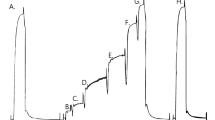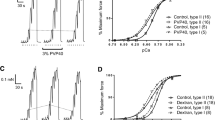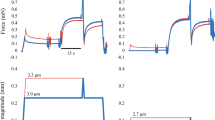Abstract
We explored to which extent maximal velocity of shortening (Vmax), force per cross-sectional area (specific tension, Po) and curvature of the force–velocity relationship (a/Po in the Hill equation) contribute to differences in peak power of single, chemically skinned rat type I fibres. Force–velocity relationships were determined from isotonic contractions of 94 maximally activated fibres. Peak power (±SD) was 3.50 ± 1.64 W L−1. There was a tenfold range of peak power and five-, six- and fourfold ranges for Po, Vmax and a/Po, respectively. None of the differences between fibres was explicable by differences in myosin heavy or light chain composition. The inverse relationship between a/Po and Vmax suggests a similar underlying cause. Fitting the data to the Huxley (Progr Biophys Biophys Chem 7:255–318, 1957) cross-bridge model showed that the rate constant g 2 and the sum of the rate constants (f + g 1) co-varied, both being low in the slowest fibres. Approximately 16% of the variation in Po could be explained by variation in the proportion of attached cycling cross-bridges (f/(f + g 1)), but the origin of most of the variance in Po remains unknown.










Similar content being viewed by others
Abbreviations
- a/Po:
-
Indication of curvature of the force–velocity relationship
- CSA:
-
Cross-sectional area
- EGTA:
-
Ethylene glycol tetra-acetic acid
- f :
-
Rate constant of cross-bridge attachment
- g 1 :
-
Rate constant of cross-bridge detachment within the positive working range
- g 2 :
-
Rate constant for cross-bridge detachment once the cross-bridge has passed the neutral position and begins to oppose shortening
- M :
-
Fraction maximal force or shortening velocity at which peak power is generated
- MHC:
-
Myosin heavy chain
- MLC:
-
Myosin light chain
- Po:
-
Specific tension, or force per fibre cross-sectional area
- SDS-PAGE:
-
Sodium dodecyl sulfate polyacrylamide gel electrophoresis
- Vmax:
-
Maximal velocity of shortening
- Vopt:
-
Shortening velocity at which maximal power is produced
References
Andruchov O, Andruchova O, Wang Y, Galler S (2006) Dependence of cross-bridge kinetics on myosin light chain isoforms in rabbit and rat skeletal muscle fibres. J Physiol 571:231–242
Bottinelli R, Schiaffino S, Reggiani C (1991) Force–velocity relations and myosin heavy chain isoform compositions of skinned fibres from rat skeletal muscle. J Physiol 437:655–672
Bottinelli R, Betto R, Schiaffino S, Reggiani C (1994) Unloaded shortening velocity and myosin heavy chain and alkali light chain isoform composition in rat skeletal muscle fibres. J Physiol 478:341–349
Bottinelli R, Canepari M, Pellegrino MA, Reggiani C (1996) Force–velocity properties of human skeletal muscle fibres: myosin heavy chain isoform and temperature dependence. J Physiol 495:573–586
Burke RE, Levine DN, Zajac FE 3rd (1971) Mammalian motor units: physiological–histochemical correlation in three types in cat gastrocnemius. Science 174:709–712
Burke RE, Levine DN, Tsairis P, Zajac FE (1973) Physiological types and histochemical profiles in motor units of the cat gastrocnemius. J Physiol 234:723–748
Close RI (1972) Dynamic properties of mammalian skeletal muscles. Physiol Rev 52:129–197
Degens H, Larsson L (2007) Application of skinned single muscle fibres to determine myofilament function in ageing and disease. J Musculoskelet Neuronal Interact 7:56–61
Degens H, Yu F, Li X, Larsson L (1998) Effects of age and gender on shortening velocity and myosin isoforms in single rat muscle fibres. Acta Physiol Scand 163:33–40
Degens H, Soop M, Hook P, Ljungqvist O, Larsson L (1999) Post-operative effects on insulin resistance and specific tension of single human skeletal muscle fibres. Clin Sci (London, England: 1979) 97:449–455
Edman KA (2010) Contractile performance of striated muscle. Adv Exp Med Biol 682:7–40
Edman KA, Reggiani C, te Kronnie G (1985) Differences in maximum velocity of shortening along single muscle fibres of the frog. J Physiol 365:147–163
Edman KA, Mansson A, Caputo C (1997) The biphasic force–velocity relationship in frog muscle fibres and its evaluation in terms of cross-bridge function. J Physiol 503:141–156
Frontera WR, Larsson L (1997) Contractile studies of single human skeletal muscle fibers: a comparison of different muscles, permeabilization procedures, and storage techniques. Muscle Nerve 20:948–952
Gilliver SF, Degens H, Rittweger J, Sargeant AJ, Jones AD (2009) Variation in the determinants of power of chemically skinned human muscle fibres. Exp Physiol 94:1070–1078
Greaser ML, Moss RL, Reiser PJ (1988) Variations in contractile properties of rabbit single muscle fibres in relation to troponin T isoforms and myosin light chains. J Physiol 406:85–98
Hill AV (1938) The heat of shortening and the dynamic constants of muscle. Proc R Soc Lond Ser B Biol Sci 126:136–195
Husom AD, Ferrington DA, Thompson LV (2005) Age-related differences in the adaptive potential of type I skeletal muscle fibers. Exp Gerontol 40:227–235
Huxley AF (1957) Muscle structure and theories of contraction. Progr Biophys Biophys Chem 7:255–318
Josephson RK, Edman KA (1988) The consequences of fibre heterogeneity on the force–velocity relation of skeletal muscle. Acta Physiol Scand 132:341–352
Katz B (1939) The relation between force and speed in muscular contraction. J Physiol 96:45–64
Lännergren J (1978) The force–velocity relation of isolated twitch and slow muscle fibres of Xenopus laevis. J Physiol 283:501–521
Larsson L, Moss RL (1993) Maximum velocity of shortening in relation to myosin isoform composition in single fibres from human skeletal muscles. J Physiol 472:595–614
Schiaffino S, Reggiani C (1996) Molecular diversity of myofibrillar proteins: gene regulation and functional significance. Physiol Rev 76:371–423
Simmons RM, Jewell BR (1974) Mechanics and models of muscular contraction. In: Linden RJ (ed) Recent advances in physiology. Churchill Livingstone, London, pp 87–147
Sweeney HL, Kushmerick MJ, Mabuchi K, Sréter FA, Gergely J (1988) Myosin alkali light chain and heavy chain variations correlate with altered shortening velocity of isolated skeletal muscle fibers. J Biol Chem 263:9034–9039
Thompson LV, Brown M (1999) Age-related changes in contractile properties of single skeletal fibers from the soleus muscle. J Appl Physiol 86:881–886
Woledge RC, Curtin NA, Homsher E (1985) Energetic aspects of muscle contraction. Monogr Physiol Soc 41:1–357
Acknowledgments
We appreciate the help of the technical staff of the animal houses at Manchester University and the Vrije Universiteit Amsterdam for the care of the animals.
Author information
Authors and Affiliations
Corresponding author
Rights and permissions
About this article
Cite this article
Gilliver, S.F., Jones, D.A., Rittweger, J. et al. Variation in the determinants of power of chemically skinned type I rat soleus muscle fibres. J Comp Physiol A 197, 311–319 (2011). https://doi.org/10.1007/s00359-010-0613-6
Received:
Revised:
Accepted:
Published:
Issue Date:
DOI: https://doi.org/10.1007/s00359-010-0613-6




